Research lays out viable pathway to “break the plastic wave.”
A new analysis by The Pew Charitable Trusts and SYSTEMIQ finds that without immediate and sustained action, the annual flow of plastic into the ocean could nearly triple by 2040. But the study also identifies solutions that could cut this volume by more than 80 percent using technologies that are available today, if key decision-makers are willing to make system-wide changes.
The findings from the scientific analysis were released today in a report, “Breaking the Plastic Wave: A Comprehensive Assessment of Pathways Towards Stopping Ocean Plastic Pollution.” The release coincides with the July 23 publication of the technical underpinnings of the report in an article in the journal Science, “Evaluating Scenarios Toward Zero Plastic Pollution.”
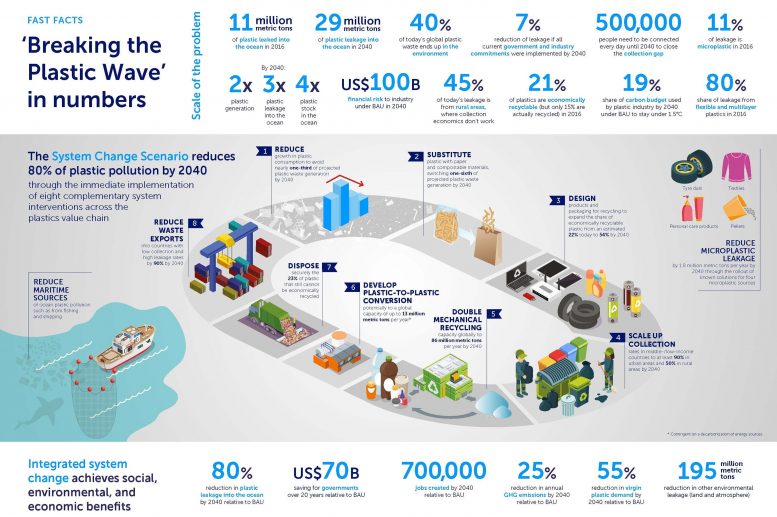
A first-of-its-kind analysis describes actions needed to stop plastic from entering the ocean. Credit: (c) The Pew Charitable Trusts/SYSTEMIQ
The research found that if no action is taken to address the projected growth in plastic production and consumption, the amount of plastic entering the ocean each year would grow from 11 million metric tons to 29 million metric tons over the next 20 years, equivalent to nearly 50 kilograms (110 pounds) of plastic on each meter of coastline worldwide. Because plastic remains in the ocean for hundreds of years and may never truly biodegrade, the cumulative amount of plastic in the ocean by 2040 could reach 600 million tons–equivalent in weight to more than 3 million blue whales. And COVID-19 has presented additional challenges in the fight to end ocean-bound plastic pollution, as single-use plastic consumption has increased during the pandemic, according to the International Solid Waste Association.
Working with scientists and experts around the world, Pew and SYSTEMIQ reached the report’s conclusions using a first-of-its-kind economic model that quantifies the flow and amount of plastic in the global system and compares the quantity of ocean plastic pollution between 2016 and 2040 under six scenarios: from no change from the projected rising flow of plastic into the ocean (noted in the report as “business-as-usual”) to a total overhaul (called the “system change scenario”) of the world’s plastics system, including its production, collection, consumption, and disposal/recycling. The model quantifies the associated cost, climate, and employment implications of each scenario.
Although progress has been made in addressing the global plastic challenge, the report finds that current commitments by government and industry will reduce the amount of plastic flowing into the ocean only by 7 percent by 2040. And without meaningful change, about 4 billion people worldwide are likely to be without organized waste collection services by 2040, contributing significantly to the projected amount of ocean plastic pollution; closing this gap would require connecting more than 500,000 people to collection services per day until 2040.
“Breaking the Plastic Wave” identifies eight measures that together could reduce by 2040 about 80 percent of the plastic pollution that flows into the ocean annually, using technology and solutions available today. Among them are reducing growth in plastic production and consumption, substituting some plastics with alternatives such as paper and compostable materials, designing products and packaging for recycling, expanding waste collection rates in middle- and low-income countries, increasing recycling, and reducing plastic waste exports. In addition to improving ocean health, adopting the changes outlined in the report could generate savings of USD$70 billion for governments by 2040, relative to business-as-usual; reduce projected annual plastic-related greenhouse gas emissions by 25 percent; and create 700,000 jobs.
While the system change scenario reduces annual ocean plastic pollution rates by more than 80 percent, it will take an unprecedented level of action and will still leave more than 5 million metric tons leaking into the ocean each year in 2040. Fully eliminating the flow of ocean plastic pollution will require dramatically increasing innovation and investment, with significant technological advances, new business models, and a greater emphasis on research and development.
“There’s no single solution to ocean plastic pollution, but through rapid and concerted action we can break the plastic wave,” said Tom Dillon, Pew’s vice president for environment. “As this report shows, we can invest in a future of reduced waste, better health outcomes, greater job creation, and a cleaner and more resilient environment for both people and nature.”
Plastic pollution presents a unique challenge for producers and users of virgin, or new, plastics given regulatory changes, such as bans on single-use plastic items, and growing consumer concern about the impact of plastic waste in the environment. But it is also a unique opportunity for providers of new and existing materials and industries that use circular business models and reuse and refill systems, which are designed to keep products and materials in use for as long as possible.
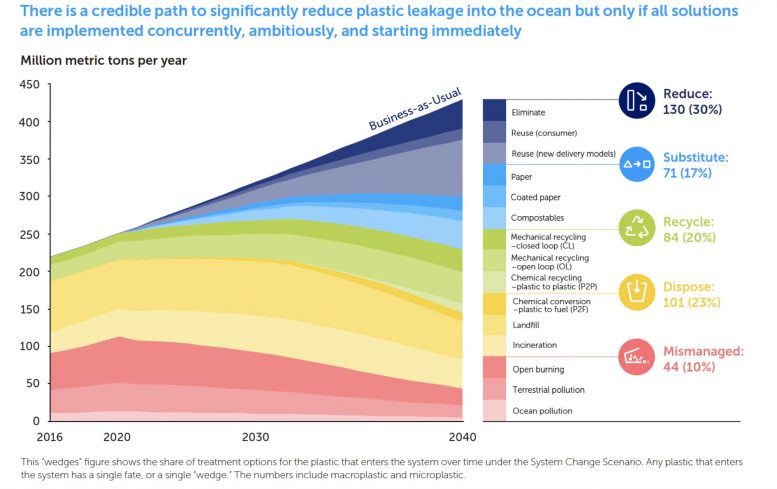
There is a credible pathway to significantly reduce ocean plastic flow into the ocean, but only if all solutions are implemented. Credit: (c) The Pew Charitable Trusts/SYSTEMIQ
“Our results indicate that the plastic crisis is solvable. It took a generation to create this challenge; this report shows we can solve it in one generation,” said Martin Stuchtey, SYSTEMIQ’s founder and managing partner. “‘Breaking the Plastic Wave’ leaves no viable excuse on the table; we have today all the solutions required to stem plastic flows by more than 80 percent. What we now need is the industry and government resolve to do so.”
###
References:
“Breaking the Plastic Wave: A Comprehensive Assessment of Pathways Towards Stopping Ocean Plastic Pollution” by The Pew Charitable Trusts.
PDF
“Evaluating scenarios toward zero plastic pollution” by Winnie W. Y. Lau, Yonathan Shiran, Richard M. Bailey, Ed Cook, Martin R. Stuchtey, Julia Koskella, Costas A. Velis,*, Linda Godfrey, Julien Boucher, Margaret B. Murphy, Richard C. Thompson, Emilia Jankowska, Arturo Castillo Castillo, Toby D. Pilditch, Ben Dixon, Laura Koerselman, Edward Kosior, Enzo Favoino, Jutta Gutberlet, Sarah Baulch, Meera E. Atreya, David Fischer, Kevin K. He, Milan M. Petit, U. Rashid Sumaila, Emily Neil, Mark V. Bernhofen, Keith Lawrence, James E. Palardy, 23 July 2020, Science.
DOI: 10.1126/science.aba9475
The University of Oxford, University of Leeds, Ellen MacArthur Foundation, and Common Seas collaborated with The Pew Charitable Trusts and SYSTEMIQ to produce “Breaking the Plastic Wave.” The report was also developed in partnership with a panel of 17 global experts.
"flow" - Google News
August 01, 2020 at 03:10AM
https://ift.tt/2PfGM9L
Plastic Flow Into Ocean Expected to Triple by 2040, But Action Could Stem Tide More Than 80% - SciTechDaily
"flow" - Google News
https://ift.tt/2Sw6Z5O
https://ift.tt/2zNW3tO
Bagikan Berita Ini
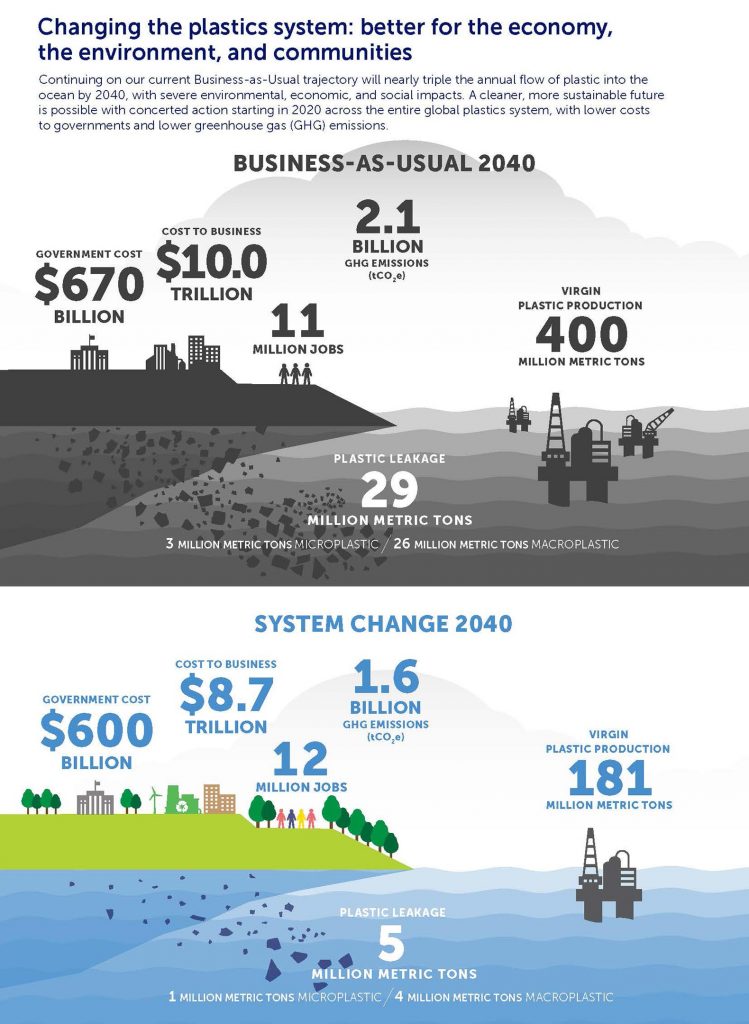
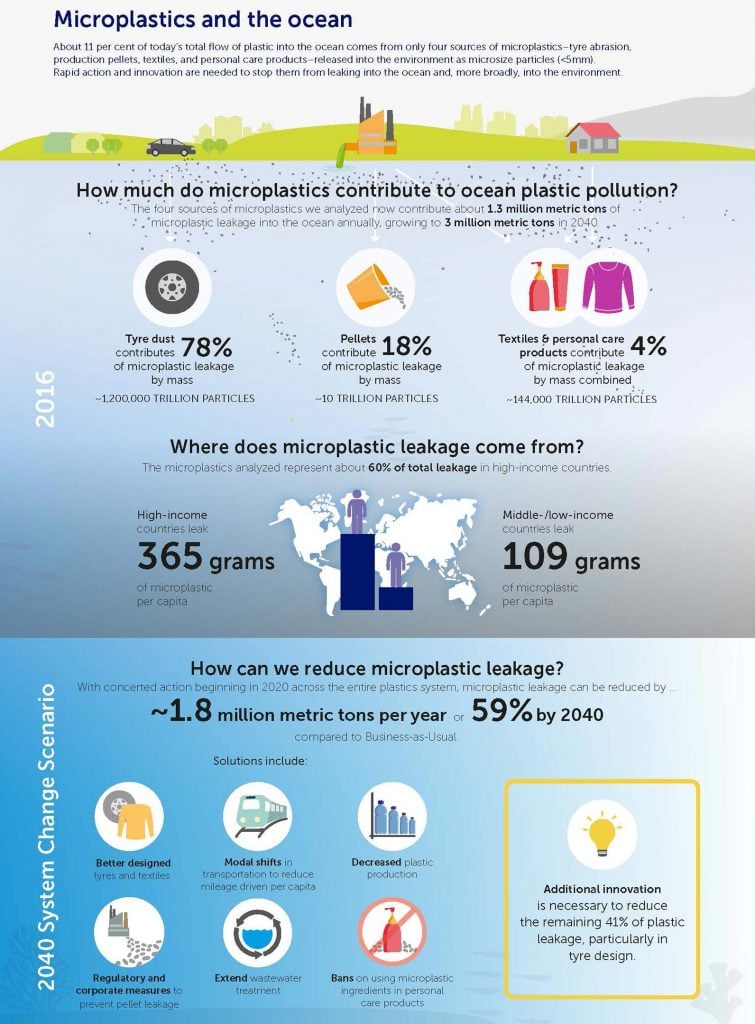
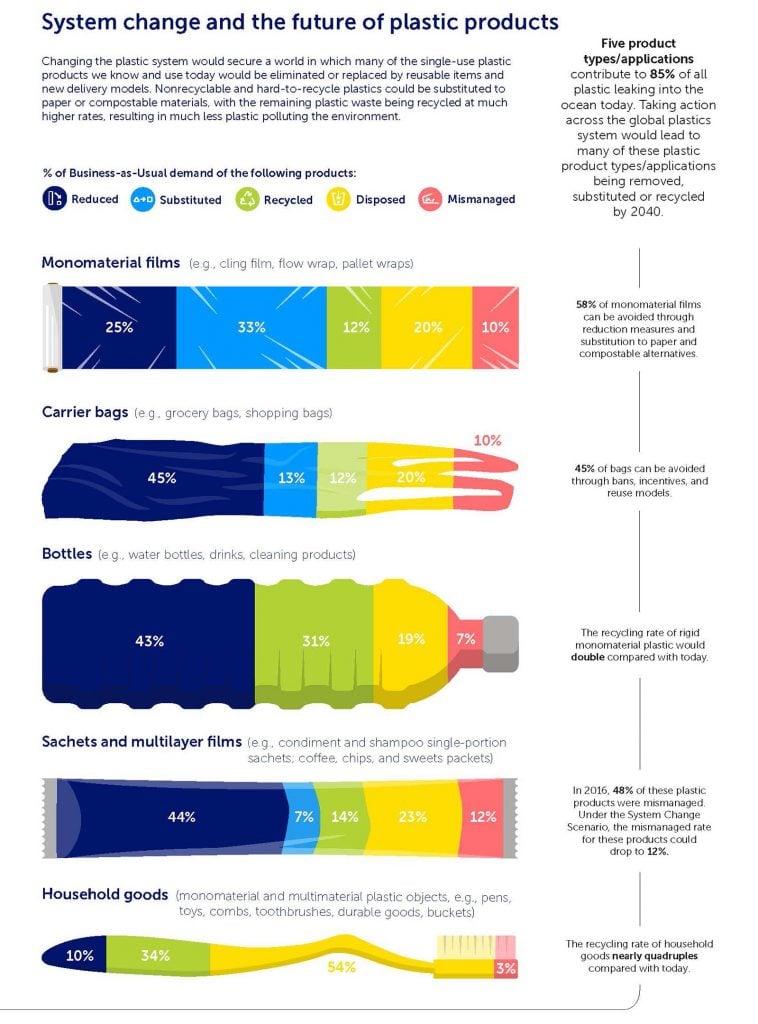














0 Response to "Plastic Flow Into Ocean Expected to Triple by 2040, But Action Could Stem Tide More Than 80% - SciTechDaily"
Post a Comment